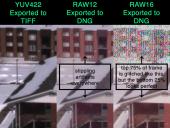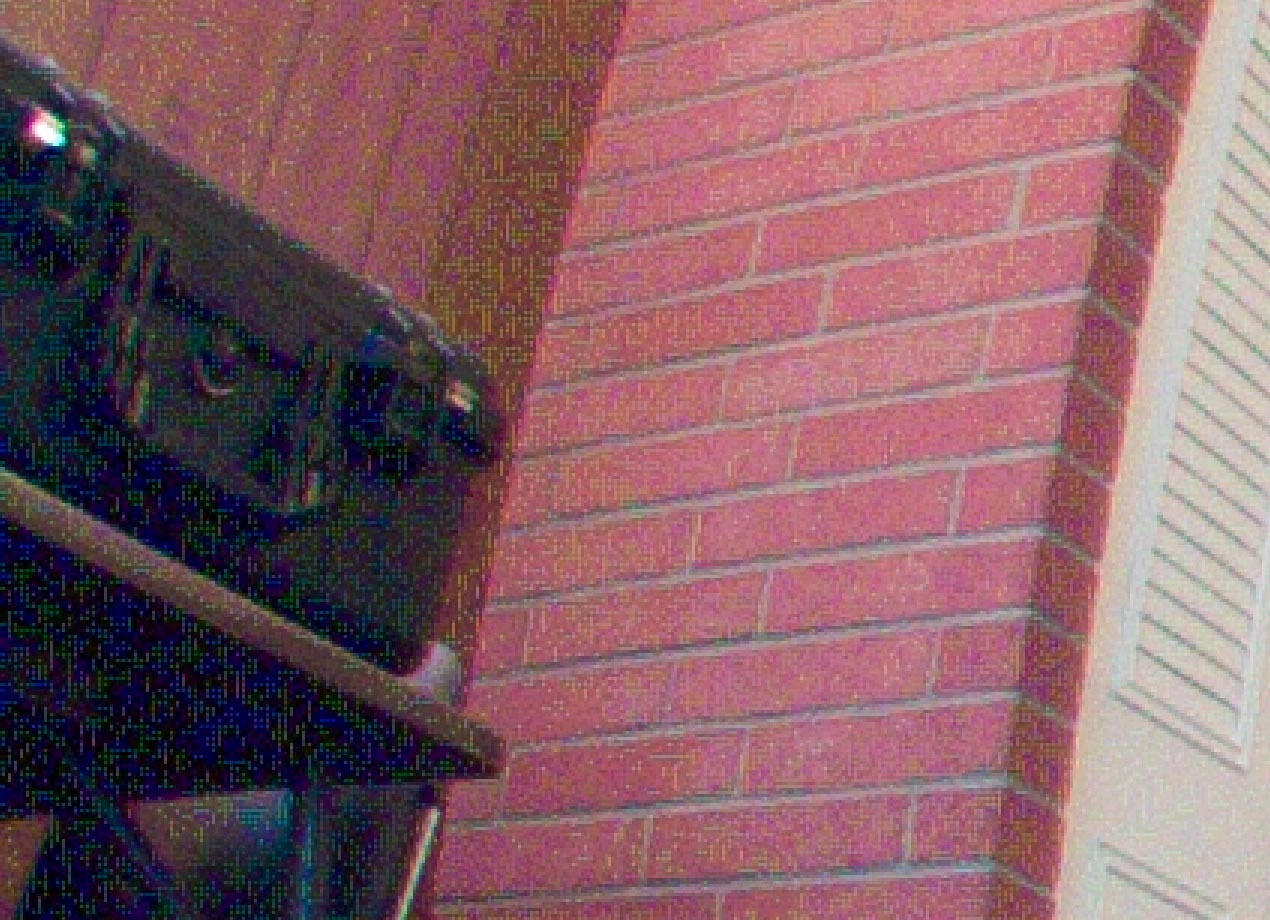
It allows to keep PV going, with more focus towards AI, but keeping be one of the few truly independent places.
-
Try this version - https://dl.dropboxusercontent.com/u/9906333/FlyCap2.exe
-
I tried your settings using dcrawms. The resulting images never matched the quality of FlyCap's YUV422 output. They were fairly splotchy and some stippling remained.
However, today I discovered something very promising. Using your version of FlyCap, I selected RAW16 instead of RAW12 and chose DNG export. When I opened up the resulting DNG in Photoshop, the top 75% was garbled, but the bottom 25% looked perfect - very similar to the YUV422, no stippling at all. I've attached a graphic that compares YUV422 exported to TIFF, RAW12 exported to DNG, and RAW16 exported to DNG.
Do you think my stippling issue could be related to bit depth interpretation?

 YUV422 RAW12 RAW16 Comparison.jpg1494 x 1128 - 266K
YUV422 RAW12 RAW16 Comparison.jpg1494 x 1128 - 266K -
Can you also try gamma = 1 and sharpness=100 ? These settings at gain=0db. Brightness should be at 0 - though this only affects the black level. This looks more like a digital artifact than a XYZ RGB mapping if its not visible at 0db.
-
Did you try the dcrawms fix I mentioned ?
-
I tried using 0db gain a couple days ago with a bright outdoor scene. Still got the same stippling artifacts.
-
Can you also try to set Gain to 0db and capture dng ? Turns out that gain is only modifying the digital gain which will definitely introduce artifacts.
> The A/D converter provides a PxGA gain stage (white balance/preamp) and VGA gain stage. The main VGA gain stage is available to the user, and is variable up to 24 dB in steps of 0.046 dB.
-
Looks like the demosaic algorithm. http://www.pages.drexel.edu/~par24/rawhistogram/40D_Demosaicing/40D_DemosaicingArtifacts.html The artifacts are similar to those with AHD and PPG. They go away when 4 color demosaicing is applied. Try dcrawms -q 4 -f -v -a The speckles left over seem to be noise and they would be reduced by dark frame methods. The explanation is interesting too..
-
Here's a dropbox link for a zip that includes a .raw12 file and a .DNG created from that file in DANcinec: https://www.dropbox.com/s/m50y2mxsrcn818x/Stippling%20Sample.zip
-
Can you post this image on dropbox so I can download it ?
-
I will use this site as a reference, and print out DNGs with various matrices. Then I will pass them to you - so you can process them. http://www.brucelindbloom.com/index.html?Eqn_RGB_XYZ_Matrix.html
Once we can figure out what works, I will incorporate them into DNG headers.
-
Do you think its the XYZ to RGB matrix ?
-
I did a couple tests to evaluate whether it's FPN.
First, I recorded 70 frames with the lens cap on and the gain set high, then I averaged those frames in Photoshop. The result is an almost pure black frame - no obvious FPN. If I boost the exposure of the average frame by +8 in Photoshop, I'm able to see some faint vertical lines and a couple hot pixels, but nothing severe. I tried subtracting the average dark frame from a normal frame shot with the same settings, but it didn't help at all with the stippling.
Second, I recorded 400 frames of panning across a room, both in and out of focus. After converting these frames to a minimally compressed video file, I'm unable to see any FPN. The noise seems utterly random.
Out of curiosity, I also shot some sunny outdoor footage with the gain at minimum. Regardless of the low gain, I get the same stippling. It's more or less just as bad as footage shot at high gain in low light.
-
Dan suggested that it could be fpn. On closer look, that looks like the case. In this case, dark frame subtraction would mitigated some of the problem. And temporal noise removal like Neat Video would help.
-
Have you tried dark frame subtraction and bad pixel removal first ? Using one of the astrophysics software. Like Pixelfixer or Deep Sky Stacker
-
It definitely doesn't look like any sensor noise I've encountered when debayering via FlyCapture, such as with the YUV422 mode. I've seen the same stippling in every DNG I've created with DANcinec. I've also tried using DANcinec to export a debayered TIFF, but even then, the stippling is present.
-
is that stippling or sensor noise? do you see it with dng generated with dancinec?
-
Here's a screenshot of the stippling.

-
can you post a screenshot of the stippling?
-
The new build has eliminated the lagging. Whether I use the streaming or buffered mode, the capture is as smooth as the stock program. And the DNGs now open up in Photoshop. Great progress!
In Photoshop, the DNGs have a couple problems. One, they have a lot of stippling, particularly in dark areas. Could something be wrong with the debayer that's being done on them? Two, Photoshop is bringing them in somewhat overexposed compared to when I captured them in FlyCap.
One interesting thing I noticed - regardless of whether I have color processing enabled, the DNGs come out looking the same. This is convenient since it means I can monitor what I'm capturing in color.
-
Try this release build for DNG - https://dl.dropboxusercontent.com/u/9906333/FlyCap2.exe Also, make sure you are using streaming mode not buffered. This one will generate the correct DNG header for any resolution you are using.
-
I've tried using the Intel USB3 driver and the Point Grey one. Both ways, the program lags the same amount.
-
Are you using the Intel USB3 drivers or the Point Gray ones ? Can you open DriverControlGui and confirm that the Point Gray drivers are being used ?
If you connect a USB stick to your laptop, can you see the USB stick ?
With the PGR drivers, you will only be able to use the USB3 ports for a PGR USB3 camera. You would need to manually swap them using the GUI to use any other USB3 devices.
-
When I try capturing 1080p24 with the RAW12 option, it captures some frames properly, but many are dropped. Sometimes the program crashes and the feed from the Flea3 is terminated.
-
Also, the build is the debug build - without optimizations.
-
Yes - its the bit swapping. The PGR bit order is messed up, so I had to do nibble and bit swapping. Can you capture 1080p24 with the RAW12 option.
Howdy, Stranger!
It looks like you're new here. If you want to get involved, click one of these buttons!
Categories
- Topics List23,990
- Blog5,725
- General and News1,353
- Hacks and Patches1,153
- ↳ Top Settings33
- ↳ Beginners256
- ↳ Archives402
- ↳ Hacks News and Development56
- Cameras2,367
- ↳ Panasonic995
- ↳ Canon118
- ↳ Sony156
- ↳ Nikon96
- ↳ Pentax and Samsung70
- ↳ Olympus and Fujifilm101
- ↳ Compacts and Camcorders300
- ↳ Smartphones for video97
- ↳ Pro Video Cameras191
- ↳ BlackMagic and other raw cameras116
- Skill1,960
- ↳ Business and distribution66
- ↳ Preparation, scripts and legal38
- ↳ Art149
- ↳ Import, Convert, Exporting291
- ↳ Editors191
- ↳ Effects and stunts115
- ↳ Color grading197
- ↳ Sound and Music280
- ↳ Lighting96
- ↳ Software and storage tips266
- Gear5,420
- ↳ Filters, Adapters, Matte boxes344
- ↳ Lenses1,582
- ↳ Follow focus and gears93
- ↳ Sound499
- ↳ Lighting gear314
- ↳ Camera movement230
- ↳ Gimbals and copters302
- ↳ Rigs and related stuff273
- ↳ Power solutions83
- ↳ Monitors and viewfinders340
- ↳ Tripods and fluid heads139
- ↳ Storage286
- ↳ Computers and studio gear560
- ↳ VR and 3D248
- Showcase1,859
- Marketplace2,834
- Offtopic1,319


